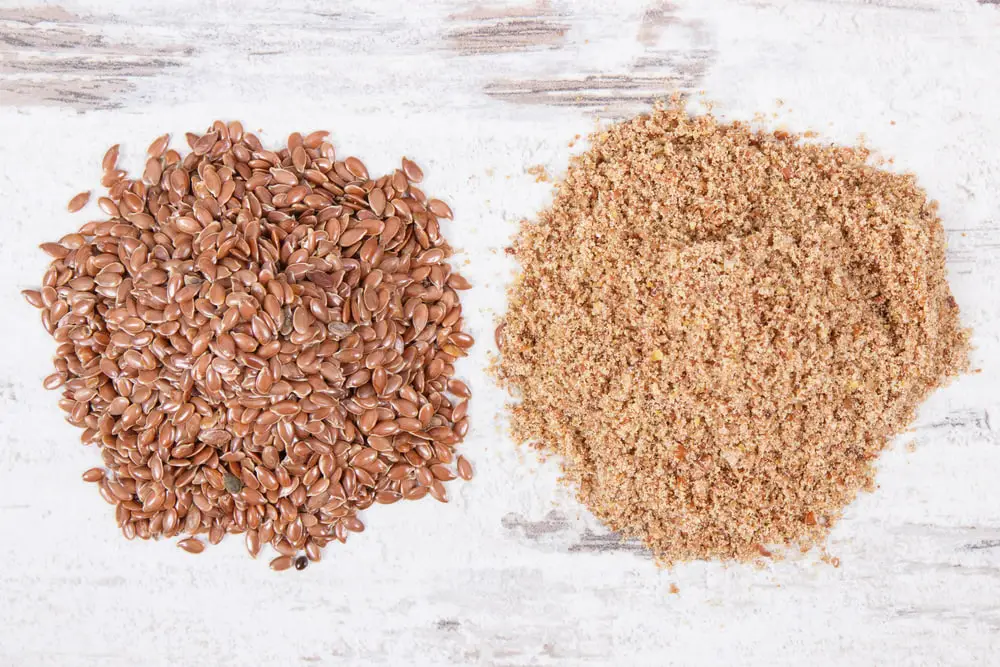Why is Flaxseed Bad for Dogs? Debunking the Myths and Uncovering the Truth
Flaxseed, a popular health food due to its omega-3 fatty acids, fiber, and lignans, has sparked debate regarding its usage in dog diets. This blog post explores flaxseed’s benefits and risks for dogs, providing guidance on safe incorporation into their diet.
Our goal is a clear understanding of flaxseed’s impact on your dog’s health.
Key takeaways
While flaxseed is generally safe for dogs, it can cause issues in large amounts due to its high fiber content, potentially leading to digestive problems.
Raw or unripe flaxseeds can be harmful to dogs because they contain harmful compounds called cyanogenic glycosides.
Some dogs may have allergic reactions to flaxseed, displaying symptoms like skin rashes, vomiting, and diarrhea.
Flaxseed oil can cause diarrhea if given in excess due to its high fat content.
Always consult with a vet before introducing new foods, like flaxseed, into your dog’s diet.
Nutritional Benefits of Flaxseed for Dogs

Flaxseed boasts a variety of nutrients that can contribute positively to your dog’s health when used correctly. In this section, we’ll discuss the key nutritional benefits of flaxseed for dogs.
1. Omega-3 Fatty Acids
Omega-3 fatty acids are essential fats that play a critical role in maintaining overall health. Flaxseed is particularly rich in alpha-linolenic acid (ALA), a type of omega-3 fatty acid. Here’s how omega-3s from flaxseed can benefit your dog:
Reducing inflammation: Omega-3 fatty acids have anti-inflammatory properties, which can help alleviate inflammation-related conditions such as arthritis, allergies, and skin irritations.
Improving skin and coat health: A diet rich in omega-3 fatty acids can help promote a shinier, healthier coat and alleviate dry, itchy skin.
2. Fiber Content
The high fiber content in flaxseed can provide additional health benefits for your dog:
Aiding digestion: Dietary fiber can help regulate your dog’s bowel movements and prevent constipation, ensuring a healthy digestive system.
Weight management: The soluble fiber in flaxseed can help dogs feel fuller for longer, making it a useful addition to a weight management plan for overweight or obese dogs.
3. Lignans
Flaxseed contains lignans, which are phytoestrogens that offer a variety of health benefits:
Antioxidant properties: Lignans act as antioxidants, helping to neutralize harmful free radicals and protect your dog’s cells from damage.
Hormone-balancing effects: Lignans may have hormone-balancing effects, potentially providing benefits for dogs with hormone-related health issues such as Cushing’s disease. However, more research is needed to fully understand the implications of lignans on canine health.
Potential Risks of Flaxseed for Dogs
While flaxseed offers numerous nutritional benefits for dogs, it’s essential to be aware of the potential risks associated with its consumption. In this section, we’ll discuss some of the concerns surrounding flaxseed for dogs.
1. Allergic reactions
Some dogs may be allergic to flaxseed, which can cause adverse reactions. It’s essential to keep an eye out for the following symptoms:
Symptoms to watch out for: Allergic reactions can manifest in various ways, including itching, skin rashes, vomiting, diarrhea, and difficulty breathing.
How to handle a suspected allergy: If you suspect your dog is allergic to flaxseed, discontinue its use and consult your veterinarian for guidance on managing the allergy and identifying suitable alternatives.
2. Gastrointestinal issues
Overconsumption of flaxseed can lead to gastrointestinal problems in dogs. It’s crucial to maintain moderation and follow the correct dosage when introducing flaxseed to your dog’s diet.
Overconsumption concerns: Too much flaxseed can result in loose stools, diarrhea, or stomach discomfort. Gradually introducing flaxseed and monitoring your dog’s reaction can help avoid these issues.
Correct dosage and moderation: Consult your veterinarian for advice on the appropriate flaxseed dosage for your dog based on their size, age, and overall health.
3. Raw flaxseed concerns
Feeding raw, whole flaxseed to your dog can pose potential risks due to the presence of cyanide compounds and the seeds’ indigestible nature.
Cyanide compounds: Raw flaxseed contains cyanogenic glycosides, which can release small amounts of cyanide when consumed. Though the levels are typically low, it’s best to avoid feeding raw flaxseed to your dog.
Proper preparation of flaxseed: To minimize risks and maximize nutritional benefits, opt for ground flaxseed or flaxseed oil. Grinding flaxseed breaks down the tough outer shell, making it easier for your dog to digest and absorb its nutrients.
Flaxseed Oil vs. Ground Flaxseed: What’s the Difference?

As you consider incorporating flaxseed into your dog’s diet, you may be wondering whether to choose flaxseed oil or ground flaxseed. In this section, we’ll compare the nutrient content, benefits, and drawbacks of each to help you make an informed decision.
Nutrient content comparison
Flaxseed oil and ground flaxseed differ in their nutrient compositions:
- Flaxseed oil is a concentrated source of omega-3 fatty acids, particularly ALA. However, it lacks the fiber and lignans found in ground flaxseed.
- Ground flaxseed contains omega-3 fatty acids, fiber, and lignans, offering a more comprehensive range of health benefits.
Benefits and drawbacks of each
Both flaxseed oil and ground flaxseed have their advantages and disadvantages:
- Flaxseed oil is an excellent option for targeting specific health concerns like inflammation or skin issues, as it provides a higher concentration of omega-3 fatty acids. However, it lacks the fiber and lignans that contribute to digestive health and antioxidant support.
- Ground flaxseed offers a more balanced nutrient profile, providing omega-3 fatty acids, fiber, and lignans. While it may not provide as high a concentration of omega-3s as flaxseed oil, it offers additional benefits in terms of digestion and antioxidant support.
Recommendations for dog owners
Ultimately, the choice between flaxseed oil and ground flaxseed will depend on your dog’s specific needs and health concerns. Consult with your veterinarian to determine which option is best for your dog and remember to introduce it gradually while monitoring your pet for any adverse reactions.
How to Safely Incorporate Flaxseed into Your Dog’s Diet

If you’ve decided to introduce flaxseed into your dog’s diet, it’s essential to do so safely and responsibly. In this section, we’ll provide some tips and guidance on incorporating flaxseed into your dog’s meals.
1. Gradual introduction
Introducing flaxseed to your dog’s diet should be done gradually to minimize the risk of gastrointestinal issues. Start with a small amount, and increase the dosage slowly over a week or two, while closely monitoring your dog’s reaction.
2. Monitoring for adverse reactions
Keep an eye out for any signs of allergies or gastrointestinal discomfort when introducing flaxseed to your dog’s diet. Symptoms may include itching, skin rashes, vomiting, diarrhea, or changes in bowel movements. If you observe any adverse reactions, stop feeding flaxseed to your dog and consult your veterinarian for guidance.
3. Serving suggestions and recipes
To make the most of flaxseed’s nutritional benefits, consider the following serving suggestions and recipes:
- For ground flaxseed, mix it into your dog’s regular food, or add it to homemade treats. Remember to store ground flaxseed in an airtight container and refrigerate it to maintain freshness and prevent spoilage.
- For flaxseed oil, you can drizzle it over your dog’s food or mix it into their meals. Store the oil in a cool, dark place, and use it within a few months to ensure optimal quality.
- If you’re feeling creative, try incorporating flaxseed into homemade dog treats like biscuits or frozen snacks. This will not only provide your dog with the nutritional benefits of flaxseed but also serve as a fun and rewarding bonding experience for both of you.
Frequently Asked Questions
Can flaxseed help with my dog’s arthritis or joint pain?
Flaxseed may help alleviate arthritis or joint pain in dogs due to its high omega-3 fatty acid content. Omega-3 fatty acids have anti-inflammatory properties, which can help reduce inflammation associated with joint pain and arthritis.
While flaxseed can be beneficial, it’s essential to consult with your veterinarian before making any dietary changes to address your dog’s specific needs and health concerns.
Are there any specific dog breeds that should avoid flaxseed?
There are no specific dog breeds known to be more susceptible to adverse reactions to flaxseed. However, individual dogs may have allergies or sensitivities to flaxseed, regardless of their breed.
It’s essential to monitor your dog for any signs of allergic reactions or gastrointestinal issues when introducing flaxseed to their diet and consult your veterinarian if you have concerns.
Can flaxseed be used as a substitute for fish oil in my dog’s diet?
Flaxseed and fish oil both contain omega-3 fatty acids, but the type and concentration of omega-3s differ between the two. Flaxseed is rich in alpha-linolenic acid (ALA), whereas fish oil contains eicosapentaenoic acid (EPA) and docosahexaenoic acid (DHA).
Dogs can convert ALA from flaxseed to EPA and DHA, but the conversion rate is limited. If your primary goal is to provide your dog with EPA and DHA, fish oil may be a more efficient source. Consult your veterinarian for guidance on choosing the best omega-3 source for your dog’s needs.
Are there any potential drug interactions with flaxseed?
While flaxseed is generally considered safe for most dogs, it’s crucial to consult your veterinarian if your dog is taking any medications, as there may be potential interactions.
Flaxseed may affect blood clotting and could interact with anticoagulant or antiplatelet medications. Additionally, the hormone-balancing effects of lignans in flaxseed might interact with hormone-related medications.
Always consult your veterinarian before introducing flaxseed to your dog’s diet if they are on any medications.
How should flaxseed be stored to ensure freshness and safety?
Proper storage is essential to maintain the freshness and safety of flaxseed products. Ground flaxseed should be stored in an airtight container in the refrigerator to prevent spoilage and maintain freshness.
Flaxseed oil should be stored in a cool, dark place, such as a pantry or cupboard, away from heat and sunlight. Once opened, it’s best to use flaxseed oil within a few months to ensure optimal quality.
Whole flaxseed can be stored in a cool, dry place, but it should be ground before feeding it to your dog to aid digestion and nutrient absorption.
Final Thoughts
Flaxseed can offer a range of nutritional benefits for dogs, including omega-3 fatty acids, fiber, and lignans, which can support their overall health and well-being. However, it’s crucial to be aware of the potential risks, such as allergies, gastrointestinal issues, and concerns surrounding raw flaxseed consumption.
When deciding whether to incorporate flaxseed into your dog’s diet, consult with your veterinarian and consider your dog’s specific needs and health concerns. If you choose to introduce flaxseed, do so gradually, and monitor your dog for any adverse reactions.
Remember, every dog is unique, and what works for one may not work for another. By staying informed, consulting with your veterinarian, and paying close attention to your dog’s reactions, you can make the best decisions for your furry friend’s health and happiness.






